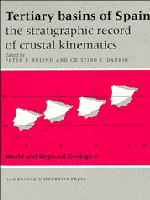Book contents
- Frontmatter
- Contents
- List of contributors
- Preface
- Dedication to Professor Oriol Riba IArderiu
- Memorial, Etienne Moissenet 1941–1994
- PART G GENERAL
- G1 Tertiary stages and ages, and some distinctive stratigraphic approaches
- G2 Cenozoic latitudes, positions and topography of the Iberian Peninsula
- G3 Tertiary tectonic framework of the Iberian Peninsula
- G4 Deep crustal expression of Tertiary basins in Spain
- G5 Oil and gas resources of the Tertiary basins of Spain
- G6 Mineral resources of the Tertiary deposits of Spain
- PART E EAST
- PART W WEST
- PART C CENTRE
- PART S SOUTH
- Index
G5 - Oil and gas resources of the Tertiary basins of Spain
Published online by Cambridge University Press: 04 August 2010
- Frontmatter
- Contents
- List of contributors
- Preface
- Dedication to Professor Oriol Riba IArderiu
- Memorial, Etienne Moissenet 1941–1994
- PART G GENERAL
- G1 Tertiary stages and ages, and some distinctive stratigraphic approaches
- G2 Cenozoic latitudes, positions and topography of the Iberian Peninsula
- G3 Tertiary tectonic framework of the Iberian Peninsula
- G4 Deep crustal expression of Tertiary basins in Spain
- G5 Oil and gas resources of the Tertiary basins of Spain
- G6 Mineral resources of the Tertiary deposits of Spain
- PART E EAST
- PART W WEST
- PART C CENTRE
- PART S SOUTH
- Index
Summary
Abstract
Gas has been produced from the Sub-Pyrenean and Guadalquivir basins, the two Tertiary foreland basins in north and south Spain. Oil and some gas are found in the post-orogenic offshore Gulf of Valencia extensional basin.
General overview
Oil and/or gas have been found in Spain in two different kinds of sedimentary basin: syn-orogenic basins, namely the Sub-Pyrenean and Guadalquivir basins, and in the post-orogenic offshore Gulf of Valencia rift basin. The first two only produce gas, although there are indications that oil-prone source rocks are present, while the last one is an oil province which also contains gas.
The Sub-Pyrenean basin
The Sub-Pyrenean basin is located in northern Spain, along the southern flank of the Pyrenees Mountains, an Alpine thrust belt, formed between late Cretaceous and early Miocene times as a direct consequence of the collision between the Iberian and European plates. Simultaneously, a foreland basin developed south of the new mountain belt and was folded and thrust by the advancing Pyrenean nappes. The main deposits are marine and Eocene in age, and these are covered by continental Oligocene and lower Miocene ‘molasse-type’ elastics (Fig. 1).
Three sub-basins developed along this margin of the Pyrenees; from west to east these are the Jaca, Tremp and Ampurdan subbasins. In each of these sub-basins the stratigraphic section and the tectonic style are different.
- Type
- Chapter
- Information
- Tertiary Basins of SpainThe Stratigraphic Record of Crustal Kinematics, pp. 20 - 25Publisher: Cambridge University PressPrint publication year: 1996
- 6
- Cited by



